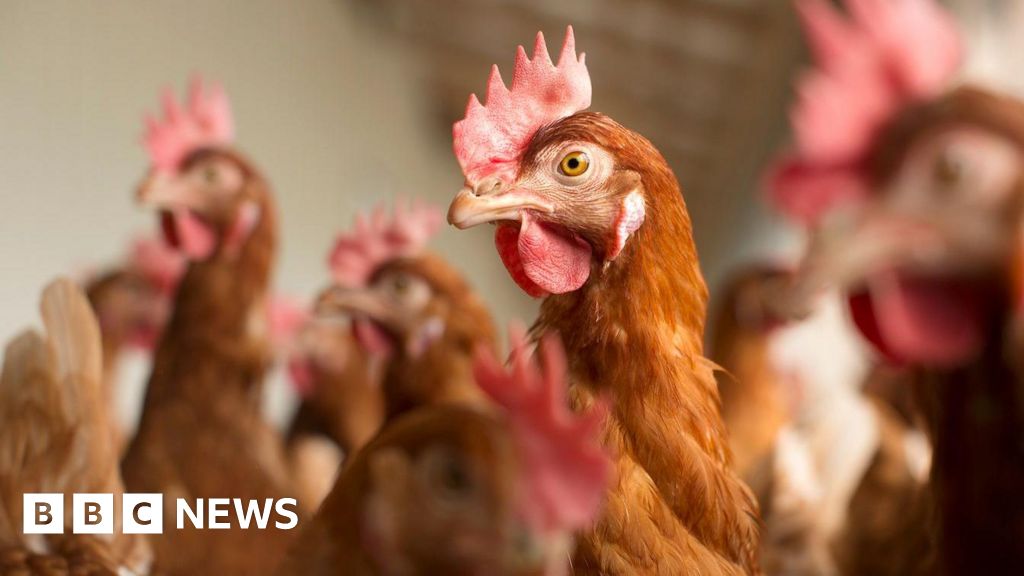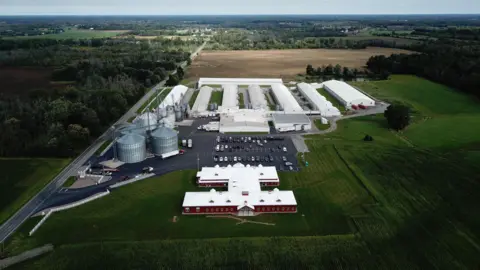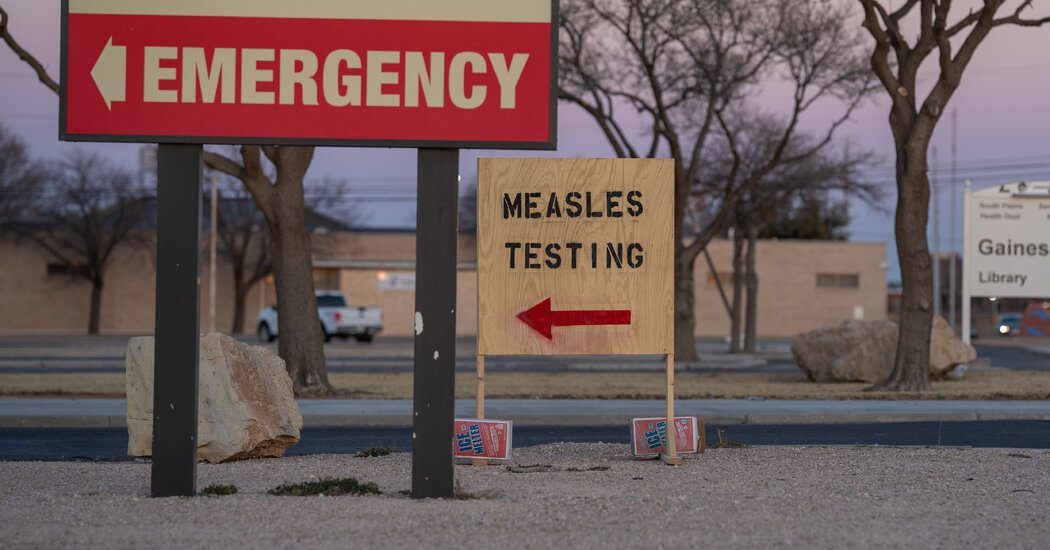
BBC News, New York
 Kreher Family Farms
Kreher Family FarmsFor Brian Kreher, a fourth-generation farmer residing in the quaint town of Clarence, New York, the recent surge in bird flu cases has led to countless restless nights.
He views his 18-acre farm as fortunate; due to rigorous safety measures, he has managed to avoid losing any birds to the virus that has devastated poultry farms nationwide.
However, the outbreak has compelled him to make difficult decisions, such as whether to welcome a new hatch of chicks from a hatchery located near a virus hotspot in Pennsylvania. Rejecting the chicks could mean a shortage of replacements for any birds that may fall ill or perish.
“I was left with no option,” Kreher stated in an interview. “It was either accept those chicks or gradually fade out of farming over the coming year.”
“Egg producers are in the midst of a severe crisis, and we are suffering losses,” he added.
Though the H5N1 strain of bird flu has circulated among U.S. poultry for several years, a severe outbreak initiated in 2022 has caused the deaths of over 156 million birds and significantly raised egg prices. Last year, the virus even infiltrated dairy cows, and a different strain linked to serious human infections was recently detected in cattle.
 Kreher Family Farms
Kreher Family FarmsThe escalating outbreak coincides with the new administration led by President Donald Trump, which has implemented significant staffing reductions and research funding cuts, raising concerns among public health specialists regarding the country’s capacity to manage bird flu and other potential pandemics.
Recently, the U.S. Department of Agriculture (USDA) informed the BBC that it had let go of several officials responsible for bird flu response efforts, only to attempt to rehire them days later. Additionally, the administration has indicated billions in budget cuts to the National Institutes of Health that scientists believe could hinder vital research on viruses.
“Currently, the risk to most Americans remains low, but the virus continues to catch us off guard, and that can change swiftly,” remarked Michaela Simoneau, a global health security fellow at the Center for Strategic and International Studies.
“I am concerned that amidst all the discussions about budget cuts, we might eliminate crucial programs that are essential,” she added.
Trump’s representatives stated they are devising a new approach to address bird flu, which will emphasize increased safety measures and vaccination, moving away from the culling of entire flocks following infections of individual birds—a method typically used to curb the spread of this highly contagious disease.
However, when pressed for details regarding this novel strategy, the White House did not disclose specifics but criticized the previous administration for “crippling American agriculture with regulatory unpredictability,” inflation, and “extreme environmental policies.”
Warnings of Viral Mutation Risks
Experts have observed several alarming signs in recent months suggesting that the avian flu virus is becoming more adept at infecting humans, according to Andrew Pekosz, a molecular biology professor at Johns Hopkins University.
Typically, influenza viruses do not reproduce effectively in mammals, making the extended presence of this virus in dairy herds concerning, as it provides more opportunities for mutation, Pekosz explained.
For the first time in U.S. history, bird flu infected cattle at the beginning of last year. To date, there have been nearly 1,000 confirmed cases across 17 states, along with 68 documented cases in humans, most of whom had close contact with the animals.
In February, a novel variant known as D1.1 was identified in dairy cows and an infected worker in Nevada, leading to two severe human infections in North America, including a teenager hospitalized in British Columbia and a fatal case in Louisiana.
This new variant also highlights instances where cows contracted the virus directly from wild birds, rather than from other cattle.
“We are witnessing significant warning signs that indicate the virus is making progress,” stated Pekosz.
The outbreak has dramatically impacted poultry and dairy farms, forcing workers to exterminate millions of birds to quell further infections. This situation has been felt by consumers in grocery stores, with egg prices surging more than 15% in January compared to the previous year, averaging $4.95 per dozen.
Despite implementing numerous security practices, such as sanitizing farm vehicles, donning steel-toed boots, and utilizing laser deterrents for wild birds, Mr. Kreher noted that the situation continues to deteriorate across the nation.
“Bird flu is a constant concern from dawn until dusk, assuming we are able to sleep at all,” he lamented. “New strategies are desperately needed in our battle against this virus.”
Trump’s Strategy Shift for Struggling Farmers
California poultry producer Christian Alexandre has directly witnessed the economic ruin that results from a bird flu outbreak. In 2022, he was forced to cull all 45,000 of his chickens when the virus spread on his family farm near the Oregon border.
“The experience was extremely painful,” recalled Mr. Alexandre, who also leads the American Pastured Poultry Producers Association.
In response to soaring egg prices, Trump’s officials have recently indicated a desire to pivot away from mass slaughters, emphasizing prevention instead.
Kevin Hassett, head of the National Economic Council, informed the BBC’s U.S. affiliate CBS News last week that he and newly appointed USDA leader Brooke Rollins are collaborating on a strategy to combat the virus utilizing “biosecurity and medical interventions.”
“Rollins and I have been coordinating with top experts within the government as well as academics nationwide and globally to establish a plan for the president by next week,” Hassett explained.
However, Mr. Alexandre expressed skepticism about the effectiveness of vaccines and other methods substituting for culling but emphasized the urgent need for innovative solutions.
“What has been done by farmers and the USDA clearly hasn’t worked,” he asserted. “We are facing a crisis.”
Vaccines for avian flu are already in use in various parts of the world, and the USDA recently granted conditional approval for a new vaccine developed by Zoetis.
Nevertheless, many poultry industry organizations oppose vaccinating flocks due to concerns that most nations will not accept imported poultry vaccinated against the disease, fearing it may obscure the virus’s true presence, according to Tom Super from the National Chicken Council.
Public health experts have criticized the U.S. administration’s approach to the bird flu outbreak since the virus first reached dairy cows, asserting that the Biden administration has not successfully enhanced disease tracking efforts.
Conversely, Trump’s administration has faced allegations of stalling communication regarding the virus, which raises further concerns among experts. Reports indicate that the Centers for Disease Control and Prevention (CDC) has suspended weekly briefings on bird flu and canceled multiple legislative updates with state health representatives.
“I have yet to witness any actions from this administration demonstrating a greater seriousness towards this outbreak,” remarked Mr. Pekosz.
On a more encouraging note, Ms. Simoneau sees the appointment of Gerald Parker, a bird flu authority, veterinarian, and former senior health official, to lead the White House’s Pandemic Office as a positive step.
However, she warns that significant funding cuts and withdrawal from the World Health Organization during Trump’s term could impede efforts to combat H5N1.
“We are isolating ourselves from the global information network at a crucial time when we require all available signals,” she stated.
Ms. Simoneau emphasized the challenges faced by any administration in tackling a possible health emergency, given public fatigue and declining trust in health officials following the COVID-19 pandemic. Yet she underscored the need for vigilance in addressing threats.
“We cannot afford to ignore the potential for this to become a human emergency, whether it happens next week or weeks down the line,” she cautioned. “Remaining vigilant is crucial.”










